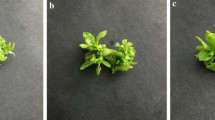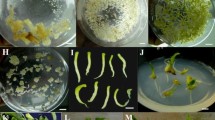Abstract
Three Indian cultivars ofL. esculentum were assessed for shoot regeneration from protoplast-derived calli. Consistent yields of viable protoplasts (>9.0×106 g f.wt.-1) were obtained from leaflets of 14 days old cultured shoots. Protoplast viability (88–94%) and planting efficiency (55–70%) were recorded for the three cultivars. Up to 71% of the protoplast-derived tissues regenerated shoots.
Similar content being viewed by others
Abbreviations
- BAP:
-
6-benzylaminopurine
- 2,4-d :
-
2,4-dichlorophenoxyacetic acid
- g f.wt.:
-
gram fresh weight
- IAA:
-
indoleacetic acid
- MS:
-
Murashige & Skoog (1962)
- NAA:
-
α-naphthaleneacetic acid
- Zea:
-
zeatin
References
Bonnema AB & O'Connell MA (1992) Molecular analysis of the nuclear organellar genotype of somatic hybrid plants between tomato (Lycopersicon esculentum) andLycopersicon chilense. Plant Cell Rep. 10: 629–632
Koorneef MH & Martinelli L (1987) A genetic analysis of cell culture traits in tomato. Theor. Appl. Genet. 74: 633–641
McCormick S, Niedermeyer J, Fry J, Barnason A, Horsch R & Fraley R (1986) Leaf disc transformation of cultivated tomato (L. esculentum) usingAgrobacterium tumefacies. Plant Cell Rep. 5: 81–84
Murashige T & Skoog F (1962) A revised medium for rapid growth and bioassays with tobacco tissue cultures. Physiol. Plant. 15: 473–497
Niedz RP, Rutter SM, Handley LW & Sink KC (1985) Plant regeneration from leaf protoplasts of six tomato cultivars. Plant. Sci. 39: 199–204
Pieterse C & Koornneef M (1988) Optimization of direct gene transfer in tomato. In: Puite KJ, Dons JJM, Huizing HJ, Kool AJ, Koornneef M & Krens FA (Eds) Progress in Plant Protoplast Research. Proc 7th Int Protoplast Symp, Wageningen (pp 357–358). Kluwer Academic Publishers, Dordrecht, The Netherlands
Shahin EA (1986) Totipotency of tomato protoplasts. Theor. Appl. Genet. 69: 325–240
Tan MMC, Rietveld EM, Van Merrewijk GAM & Kool AJ (1987) Regeneration of leaf mesophyll protoplasts of tomato cultivars (L. esculentum): factors important for efficient protoplast culture and plant regeneration. Plant Cell Rep. 6: 172–175
Tewes A, Glund K, Walther R & Reinbothe H (1984) High yield isolation and rapid recovery of protoplasts from suspension culture of tomato (L. esculentum). Z.Pflanzenphysiol. 113: 141–150
Wijbrandi J, van Capelle WV, Hanhart CJ, van Leonen Matinet-Schuringa EP & Koornneef M (1990) Selection and characterization of somatic hybrids betweenL. esculentum andL. peruvianum. Plant Sci. 70: 197–208
Author information
Authors and Affiliations
Rights and permissions
About this article
Cite this article
Patil, R.S., Davey, M.R. & Power, J.B. Highly efficlent plant regeneration from mesophyll protoplasts of Indian field cultivars of tomato (Lycopersicon esculentum). Plant Cell Tiss Organ Cult 36, 255–258 (1994). https://doi.org/10.1007/BF00037728
Received:
Accepted:
Issue Date:
DOI: https://doi.org/10.1007/BF00037728




